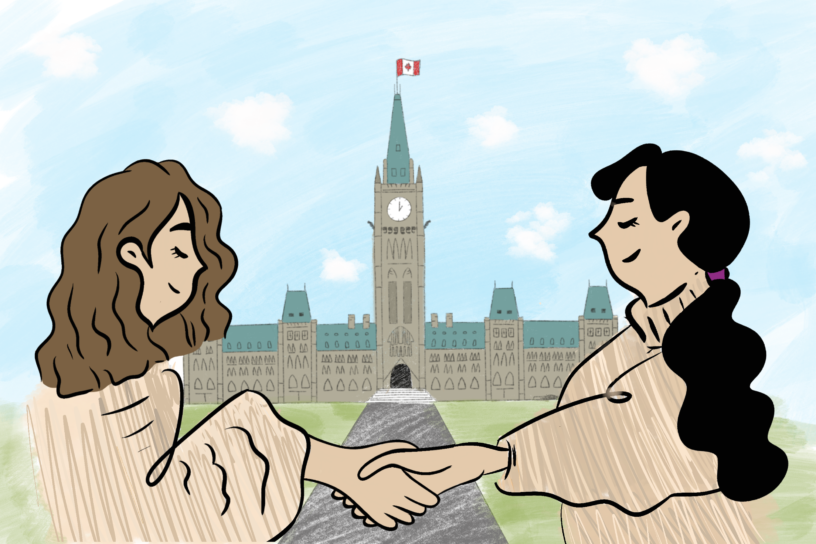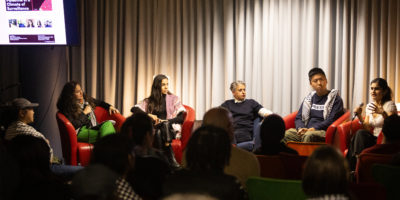By Lama Alshami
Throughout the past 100 years, women’s representation in Canadian politics has greatly increased, yet students and faculty at Toronto Metropolitan University (TMU) believe barriers to their political participation remain.
On Oct. 18, 1929, the Persons Case established that women were included in the legal definition of “persons” under Canadian law. This historic case allowed women to be appointed to the Senate and work in the House of Commons.
Peggy Nash, a former member of Parliament for the New Democratic Party and current labour fellow with the faculty of arts at TMU said despite the monumental step that paved the way for women’s participation in politics today, a lot of work remains to combat stereotypes.
“The change in representation, I think, has been much slower than anyone expected,” she said.
Sarah Roopnauth, a criminology student in her final year of Indo-Guyanese descent, reflected on intersectional identities in political spaces.
“Women of colour tend to be underrepresented and their voices tend to be unrecognized,” Roopnauth said.
On Aug. 27, 1927, the Famous Five, a group of activist women, petitioned to challenge a limitation that prevented women from being appointed to the Senate. The Supreme Court of Canada’s ruling on the petition continued to uphold this prohibition using Section 24 of the Constitution Act—where only qualified persons could be summoned—and the usage of only the “he” pronoun in the act as justification.
The Famous Five then took their case to the Judicial Committee of the Privy Council, Canada’s highest court of appeal at the time located in London, England.
On Oct. 18, 1929, the Privy Council reversed the Supreme Court’s decision and ruled that the term “persons” in Section 24 does include women and they are eligible to become members of the Senate.
“Having [as many] female voices in our government systems as possible would definitely bring lots of valuable people to the front line”
Lord Sankey, who delivered the judgement, said the “exclusion of women from all public offices is a relic of days more barbarous than ours…and to those who ask why the word [persons] should include females, the obvious answer is why should it not.”
Almost a century later, the Canadian Senate currently has more women than men—56.5 percent of 105 senators. According to IPU Parline, Canada has the second-highest percentage of women legislators in the upper house across the globe, following behind Australia.
“Certainly, there’s much greater representation politically than we have had in the past, but women are still only about a third of our members of Parliament,” said Nash.
“It is overwhelmingly male, overwhelmingly white. I think that Parliament, while it is changing slowly, it’s a colonial structure that has not always been welcoming,” she added.
Many students at TMU said they feel discouraged when they don’t see people who look like them in positions of power.
Noa Mammone, a second-year politics and governance student, said it’s not motivating for her, especially as a politics student, to see the lack of women represented in the Canadian government.
“Having [as many] female voices in our government systems as possible would definitely bring lots of valuable, valuable people to the front line,” she said.
Although progressive for its time, the Persons Case did not incorporate racialized women including Indigenous women and more. Today, women of colour continue to face challenges for representation. After Canada’s federal election in 2019, only 21 per cent of women elected were racialized and just three per cent were Indigenous.
“As much as Canada likes to praise itself for diversity, we still have a huge barrier when it comes to including women of colour in political decisions or in political fields as well,” said Roopnauth.
Roopnauth is also the co-president of the student group TMU Women of Colour in Law (WocInLaw). She said their goal is to “subvert racial and gender barriers within the field.”
“Women of colour tend to be underrepresented and their voices tend to be unrecognized”
“Seeing people who are the same gender, same race as you, really inspires you to think like, ‘Oh, that could be me one day,’” she said.
“Just having that support network for women of colour, to see people who are also trying to achieve the same goal is very helpful in creating motivations for those persons as well,” said Roopnauth, referring to WocInLaw.
Vanessa Reale, a biracial fourth-year criminology student, said the political and legal processes in Canada today are still structured to cater to men.
“We do see individuals facing struggles because of the historical roots of male domination and power dynamics in society,” she said.
She explained that during her internship with Ontario’s Office of Comptroller General as a legal assistant, the office was filled with men. Only one other woman was working there and she was an office assistant.
She pointed out that the highest-paid positions, the decision-makers and the important roles were all dominated by men.
“We have the constitutional ruling of the Persons Case where it shows that women are capable, women are deserving. It’s just a matter of them now proving themselves and continuing to build a foundation for women of the future,” said Reale.
Rajneet Farma, a fourth-year politics and governance student, said the political figures people think of usually aren’t women. For one of her classes, she asked people on campus to draw political party leaders on paper and none of them drew a woman.
She believes we need to work to break that barrier and show that “women can be those strong [and] bigger heads.”
While Canada has made a lot of progress since the Persons Case in 1929 with many more women in government, Farma posed the question, “Are [women politicians] actually pushing the interests of women?”
She said it’s important for women in power to work towards fighting for women’s rights in regards to reproductive care, battling the wage gap and more. When it comes to voting, women still encounter discouragement and a lack of empowerment in their choices.
“Even when women do vote, it tends to be a vote where the only options are white men,” Roopnauth said.
“I think that Parliament, while it is changing slowly, it’s a colonial structure that has not always been welcoming”
In her experience, Nash said women often disengage in politics and attributes this to some women being too busy or turned off by the climate of politics.
“I hear lots of comments from women about their dislike of politics, that they think it’s too confrontational, macho, negative…and I don’t think it has to be that way,” said Nash.
She described situations where she would go door-knocking during campaigning periods and some women would tell her, “I’m busy, talk to my husband.”
Nash thinks women should be encouraged to express their views and priorities, even if they challenge the status quo.
On the other hand, there are initiatives being done to decrease gender disparities within politics.
Reale said that in another one of her internships, while she noticed that all the C-level executives were men, the chief executive officer (CEO) sought out greater diversity in the workplace.
The CEO voiced to Reale that he was hiring more women in positions of power because he noticed that their qualifications, education and experience were the same as men.
“It’s just a matter of giving them a chance to prove themselves in that position,” said Reale.
“Seeing people who are the same gender, same race as you, really inspires you to think like, ‘Oh, that could be me one day,’”
Nash co-leads the Women in the House program at TMU alongside politics and governance professor Tracey Raney, which combines academic and experiential learning to equip students with an understanding of political leadership and intersectional policymaking.
The program covers the structure of Canadian politics, gender-related issues and barriers to representation. Students receive training in networking, public speaking and developing political briefing notes. They also get the opportunity to shadow a woman MP, witness parliamentary debates and tour the House of Commons and Senate.
She said she hopes this program raises awareness for women on how politics functions and how they can engage, even if only through voting.
In a world of greater confrontation and polarization, Nash said “women can play a unique role in being a voice of engagement, of negotiation, of strong public policy and maybe a little more sanity.”
Reale said it is very important to be involved in civil rights, advocacy and voting as women and marginalized groups did not always have that right.
“Being able to utilize that right now and use it to our advantage to help better our future and our current socio-economic standpoint is very critical and important,” she added.











Leave a Reply